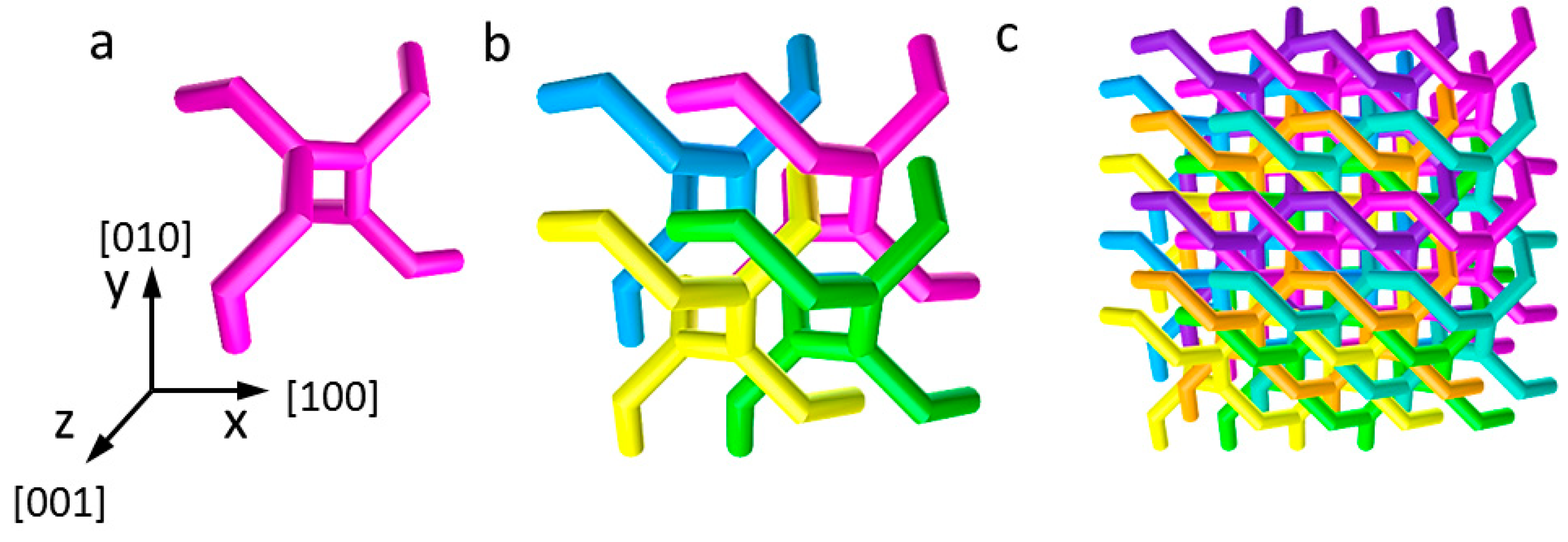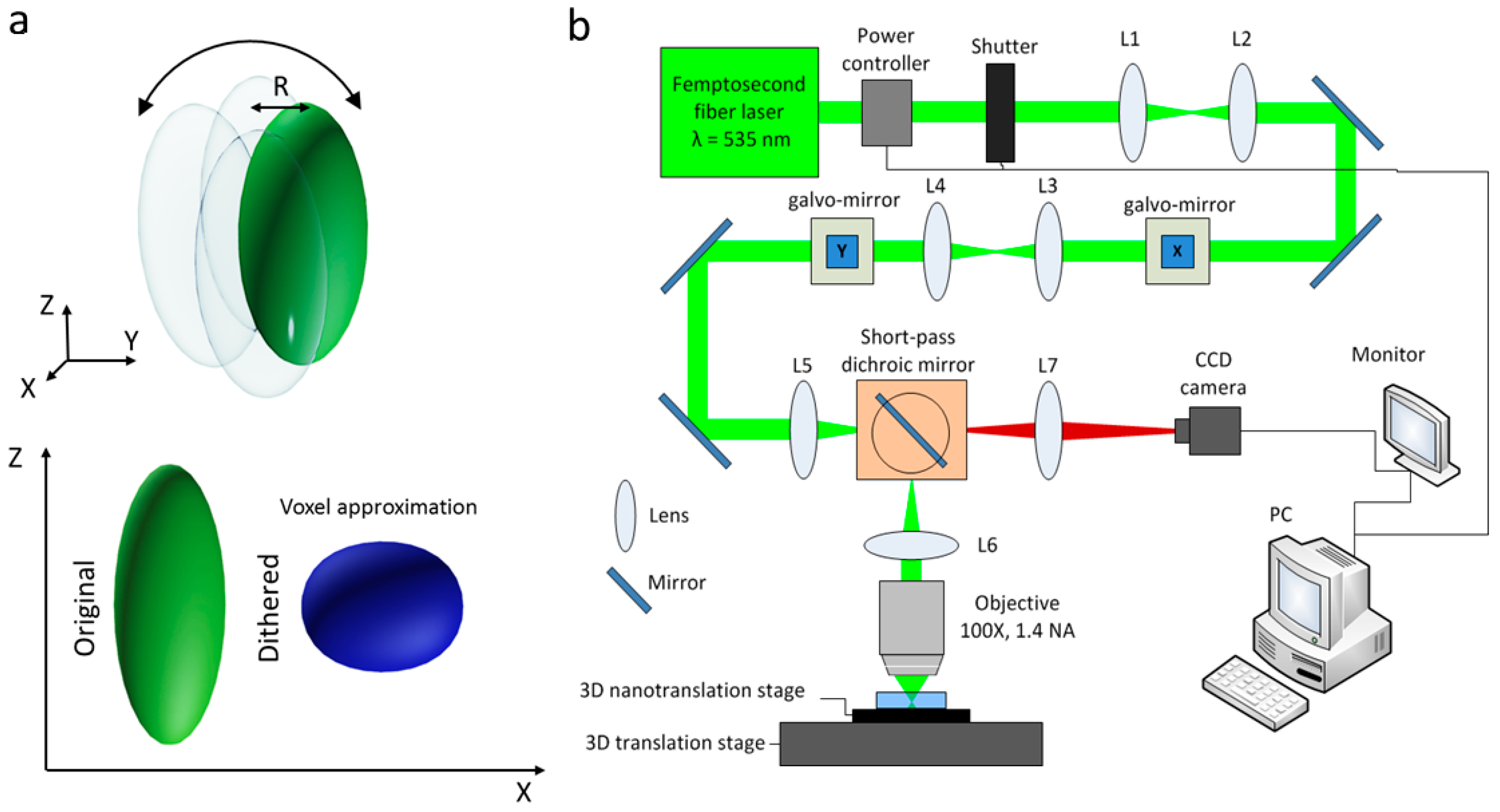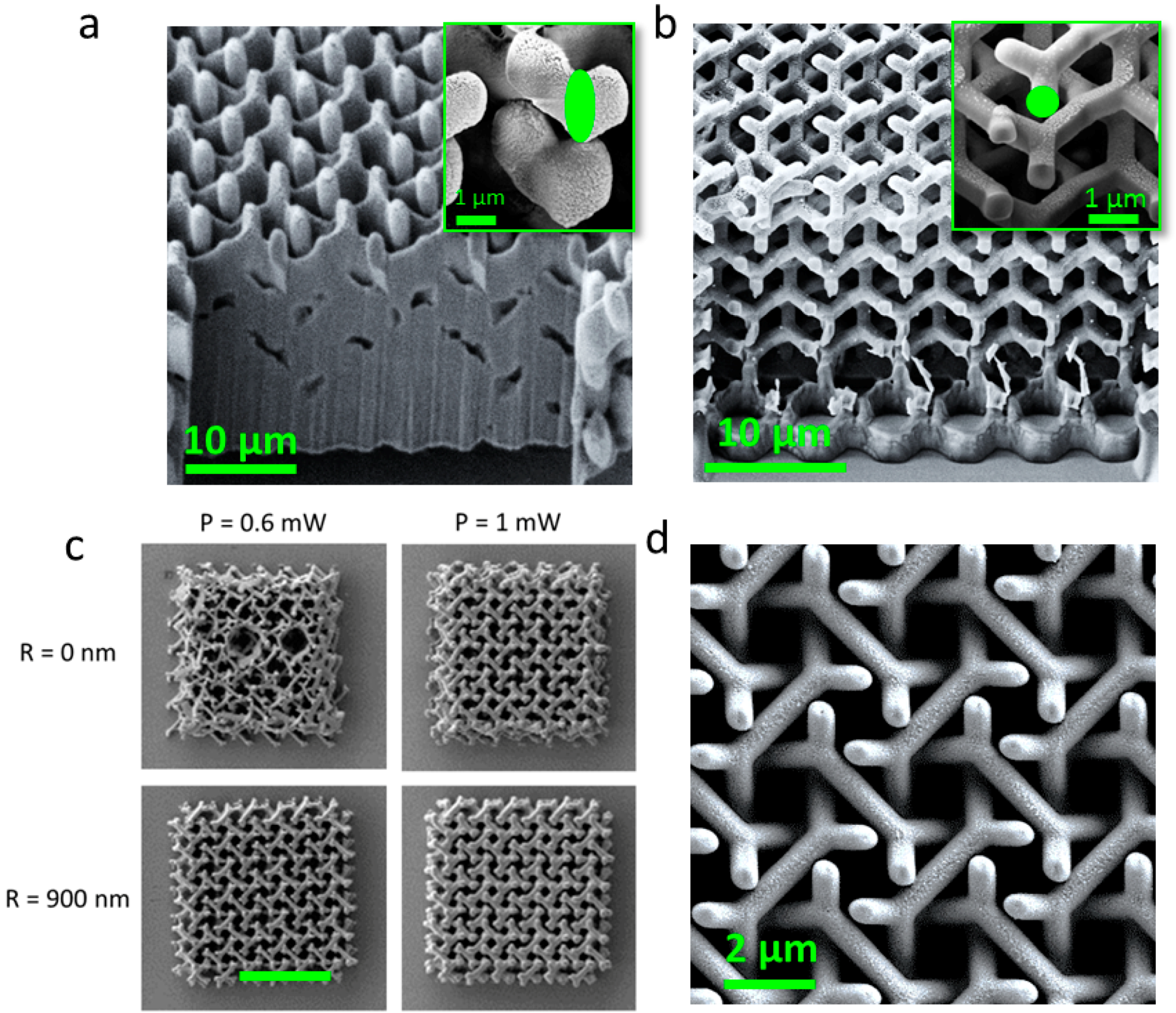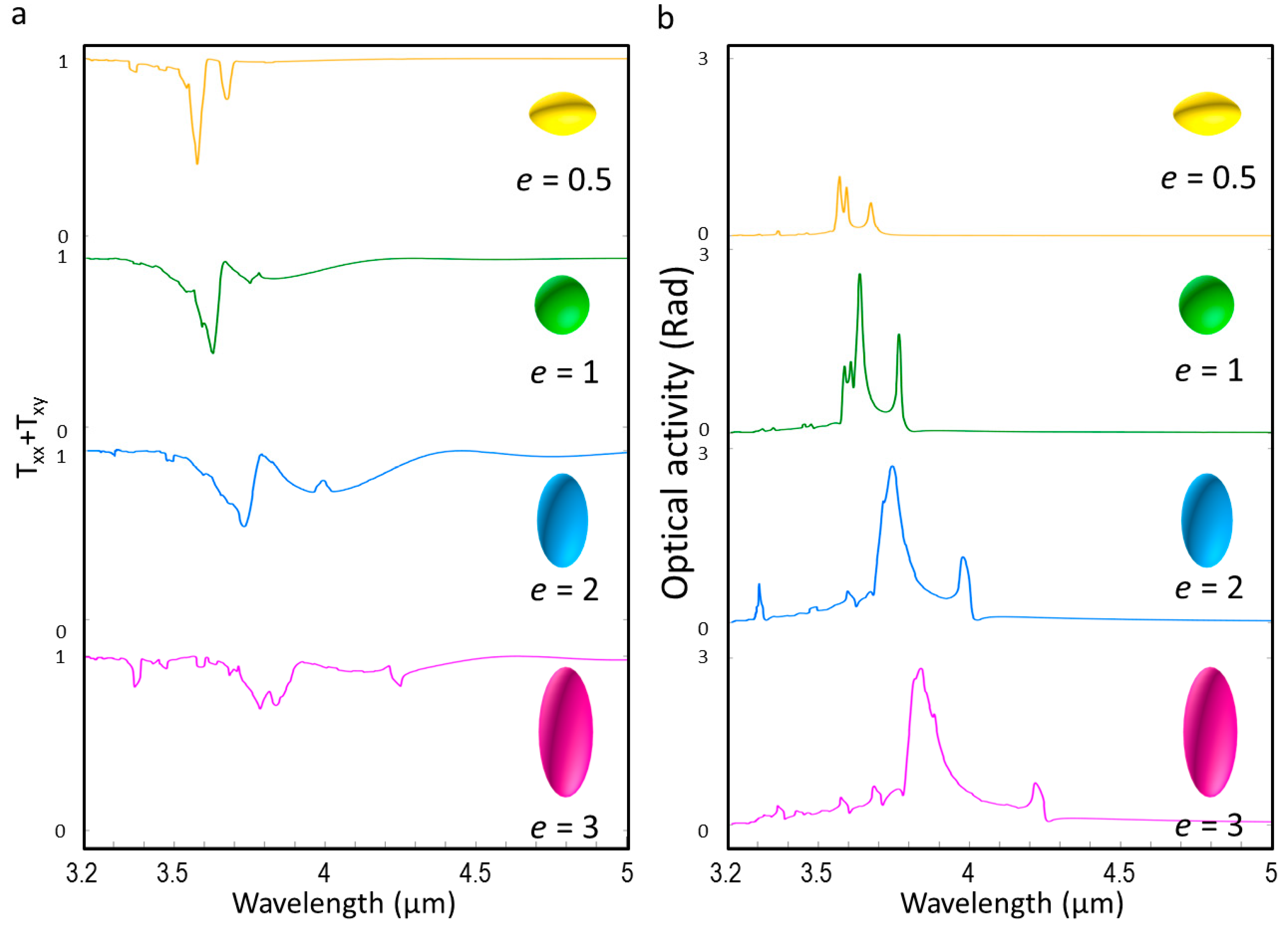Impact of Cubic Symmetry on Optical Activity of Dielectric 8-srs Networks
Abstract
1. Introduction
2. Materials and Methods
2.1. Galvo-Dithered Direct Laser Writing
2.2. Experimental Characterization
2.3. Simulations
3. Results and Discussion
3.1. Fabrication
3.2. Impact of Cubic Symmetry on Optical Activity
3.3. Experimental Characterization
4. Conclusions
Supplementary Materials
Author Contributions
Funding
Acknowledgments
Conflicts of Interest
References
- Cvijetic, N.; Milione, G.; Ip, E.; Wang, T. Detecting lateral motion using light’s orbital angular momentum. Sci. Rep. 2015, 5, 1–7. [Google Scholar] [CrossRef] [PubMed]
- Nair, R.V.; Vijaya, R. Photonic crystal sensors: An overview. Prog. Quantum Electron. 2010, 34, 89–134. [Google Scholar] [CrossRef]
- Wang, H.; Zhang, K.Q. Photonic crystal structures with tunable structure color as colorimetric sensors. Sensors 2013, 13, 4192–4213. [Google Scholar] [CrossRef] [PubMed]
- Sabri, N.; Aljunid, S.A.; Salim, M.S.; Ahmad, R.B.; Kamaruddin, R. Toward optical sensors: Review and applications. J. Phys. Conf. Ser. 2013, 423. [Google Scholar] [CrossRef]
- González, L.A. Review on integrated optical sensors and its applications. In Proceedings of the 2017 IEEE Mexican Humanitarian Technology Conference (MHTC), Puebla, Mexico, 29–31 March 2017; pp. 170–173. [Google Scholar]
- Joannopoulos, J.D.; Johnson, S.; Winn, J.N.; Meade, R.D. Photonic Crystals: Molding the Flow of Light; Priceton University Press: Princeton, NJ, USA, 2008; ISBN 9780691124568. [Google Scholar]
- Sinibaldi, A.; Sampaoli, C.; Danz, N.; Munzert, P.; Sibilio, L.; Sonntag, F.; Occhicone, A.; Falvo, E.; Tremante, E.; Giacomini, P.; et al. Biosensors and Bioelectronics Detection of soluble ERBB2 in breast cancer cell lysates using a combined label-free/fl uorescence platform based on Bloch surface waves. Biosens. Bioelectron. 2017, 92, 125–130. [Google Scholar] [CrossRef] [PubMed]
- Sriram, R.; Baker, J.E.; Fauchet, P.M.; Miller, B.L. Two dimensional photonic crystal biosensors as a platform for label-free sensing of biomolecules. Proc. SPIE 2013, 8570. [Google Scholar] [CrossRef]
- Fischer, J.; Wegener, M. Three-dimensional optical laser lithography beyond the diffraction limit. Laser Photonics Rev. 2013, 7, 22–44. [Google Scholar] [CrossRef]
- Lim, C.Y.; Choi, E.; Park, Y.; Park, J. 3D photonic crystal-based biosensor functionalized with quantum dot-based aptamer for thrombine detection. Proc. SPIE 2014, 9127. [Google Scholar] [CrossRef]
- Schoen, A.H. Infinite Periodic Minimal Surfaces without Self-Intersections; NASA-TN-D-5541; NASA: Washington, DC, USA, 1970; p. 92.
- Dolan, J.A.; Wilts, B.D.; Vignolini, S.; Baumberg, J.J.; Steiner, U.; Wilkinson, T.D. Optical properties of gyroid structured materials: From photonic crystals to metamaterials. Adv. Opt. Mater. 2015, 3, 12–32. [Google Scholar] [CrossRef]
- Saba, M.; Turner, M.D.; Mecke, K.; Gu, M.; Schröder-Turk, G.E. Group theory of circular-polarization effects in chiral photonic crystals with four-fold rotation axes applied to the eight-fold intergrowth of gyroid nets. Phys. Rev. B Condens. Matter Mater. Phys. 2013, 88, 245116. [Google Scholar] [CrossRef]
- Saba, M.; Thiel, M.; Turner, M.D.; Hyde, S.T.; Gu, M.; Grosse-Brauckmann, K.; Neshev, D.N.; Mecke, K.; Schröder-Turk, G.E. Circular dichroism in biological photonic crystals and cubic chiral nets. Phys. Rev. Lett. 2011, 106, 103902. [Google Scholar] [CrossRef] [PubMed]
- Peng, S.; Zhang, R.; Chen, V.H.; Khabiboulline, E.T.; Braun, P.; Atwater, H.A. Three-Dimensional Single Gyroid Photonic Crystals with a Mid-Infrared Bandgap. ACS Photonics 2016, 3, 1131–1137. [Google Scholar] [CrossRef]
- Singh, V.; Lin, P.T.; Patel, N.; Lin, H.; Li, L.; Zou, Y.; Deng, F.; Ni, C.; Hu, J.; Giammarco, J.; et al. Mid-infrared materials and devices on a Si platform for optical sensing. Sci. Technol. Adv. Mater. 2014, 15, 014603. [Google Scholar] [CrossRef] [PubMed]
- Schliesser, A.; Picqué, N.; Hänsch, T.W. Mid-infrared frequency combs. Nat. Photonics 2012, 6, 440–449. [Google Scholar] [CrossRef]
- Active, H.O.W.; Policy, S.; Benefit, C.A.N.; All, U.S. Editorial Extending opportunities. Nat. Photonics 2012, 6. [Google Scholar] [CrossRef]
- Khaderi, S.N.; Deshpande, V.S.; Fleck, N.A. The stiffness and strength of the gyroid lattice. Int. J. Solids Struct. 2014, 51, 3866–3877. [Google Scholar] [CrossRef]
- Turella, F.; Cumming, B.P.; Schröder-Turk, G.E.; Gu, M. Observation of optical activity in dielectric biomimetic 8-srs networks. Opt. Lett. 2015, 40, 4795–4798. [Google Scholar] [CrossRef] [PubMed]
- Kuwata-Gonokami, M.; Saito, N.; Ino, Y.; Kauranen, M.; Jefimovs, K.; Vallius, T.; Turunen, J.; Svirko, Y. Giant optical activity in quasi-two-dimensional planar nanostructures. Phys. Rev. Lett. 2005, 95, 1–4. [Google Scholar] [CrossRef] [PubMed]
- Ren, M.; Plum, E.; Xu, J.; Zheludev, N.I. Giant nonlinear optical activity in a plasmonic metamaterial. Nat. Commun. 2012, 3, 833–836. [Google Scholar] [CrossRef] [PubMed]
- Kresge, C.T.; Leonowicz, M.E.; Roth, W.J.; Vartuli, J.C.; Beck, J.S. Ordered mesoporous molecular sieves synthesized by a liquid-crystal template mechanism. Nature 1992, 359, 710–712. [Google Scholar] [CrossRef]
- Lin, E.L.; Hsu, W.L.; Chiang, Y.W. Trapping Structural Coloration by a Bioinspired Gyroid Microstructure in Solid State. ACS Nano 2018, 12, 485–493. [Google Scholar] [CrossRef] [PubMed]
- Lin, T.H.; Li, Y.; Wang, C.T.; Jau, H.C.; Chen, C.W.; Li, C.C.; Bisoyi, H.K.; Bunning, T.J.; Li, Q. Red, green and blue reflections enabled in an optically tunable self-organized 3D cubic nanostructured thin film. Adv. Mater. 2013, 25, 5050–5054. [Google Scholar] [CrossRef] [PubMed]
- Urbas, A.M.; Maldovan, M.; DeRege, P.; Thomas, E.L. Bicontinuous cubic block copolymer photonic crystals. Adv. Mater. 2002, 14, 1850–1853. [Google Scholar] [CrossRef]
- Goi, E.; Cumming, B.P.; Gu, M. Gyroid “srs” Networks: Photonic Materials Beyond Nature. Adv. Opt. Mater. 2018. [Google Scholar] [CrossRef]
- Fischer, J.; Wegener, M. Three-dimensional direct laser writing inspired by stimulated-emission-depletion microscopy. Opt. Mater. Express 2011, 1, 614–624. [Google Scholar] [CrossRef]
- Goi, E.; Yue, Z.J.; Cumming, B.P.; Gu, M. Observation of Type I Photonic Weyl Points in Optical Frequencies. Laser Photonics Rev. 2017. [Google Scholar] [CrossRef]
- Goi, E.; Yue, Z.; Cumming, B.P.; Gu, M. A Layered-Composite Nanometric Sb 2 Te 3 Material for Chiral Photonic Bandgap Engineering. Appl. Mater. Sci. 2018, 215. [Google Scholar] [CrossRef]
- Goi, E.; Mashford, B.S.; Cumming, B.P.; Gu, M. Tuning the refractive index in gyroid photonic crystals via lead-chalcogenide nanocrystal coating. Adv. Opt. Mater. 2016, 4, 226–230. [Google Scholar] [CrossRef]
- Turner, M.D.; Schröder-Turk, G.E.; Gu, M. Fabrication and characterization of three-dimensional biomimetic chiral composites. Opt. Express 2011, 19, 10001. [Google Scholar] [CrossRef] [PubMed]
- Turner, M.D.; Saba, M.; Zhang, Q.; Cumming, B.P.; Schröder-Turk, G.E.; Gu, M. Miniature chiral beamsplitter based on gyroid photonic crystals. Nat. Photonics 2013, 7, 801–807. [Google Scholar] [CrossRef]
- Cumming, B.P.; Schröder-Turk, G.E.; Debbarma, S.; Gu, M. Bragg-mirror-like circular dichroism in bio-inspired quadruple-gyroid 4srs nanostructures. Light Sci. Appl. 2017, 6, e16192. [Google Scholar] [CrossRef] [PubMed]
- Martínez-Corral, M.; Ibáñez-López, C.; Saavedra, G. Axial gain resolution in optical sectioning fluorescence microscopy by shaded-ring filters. Opt. Express 2003, 11, 1740–1745. [Google Scholar] [CrossRef] [PubMed]
- Staude, I.; Thiel, M.; Essig, S.; Wolff, C.; Busch, K.; von Freymann, G.; Wegener, M. Fabrication and characterization of silicon woodpile photonic crystals with a complete bandgap at telecom wavelengths. Opt. Lett. 2010, 35, 1094–1096. [Google Scholar] [CrossRef] [PubMed]
- Nicoletti, E.; Bulla, D.; Luther-Davies, B.; Gu, M. Wide-angle stop-gap chalcogenide photonic crystals generated by direct multiple-line laser writing. Appl. Phys. B Lasers Opt. 2011, 105, 847–850. [Google Scholar] [CrossRef]
- Terzaki, K.; Vasilantonakis, N.; Gaidukeviciute, A.; Reinhardt, C.; Fotakis, C.; Vamvakaki, M.; Farsari, M. 3D conducting nanostructures fabricated using direct laser writing. Opt. Mater. Express 2011, 1, 586–597. [Google Scholar] [CrossRef]
- Mirshafieyan, S.S.; Gregory, D.A. Electrically tunable perfect light absorbers as color filters and modulators. Sci. Rep. 2018, 8, 1–9. [Google Scholar] [CrossRef] [PubMed]
- Zeng, B.; Gao, Y.; Bartoli, F.J. Ultrathin nanostructured metals for highly transmissive plasmonic subtractive color filters. Sci. Rep. 2013, 3, 1–9. [Google Scholar] [CrossRef] [PubMed]
- Mao, K.; Shen, W.; Yang, C.; Fang, X.; Yuan, W.; Zhang, Y.; Liu, X. Angle insensitive color filters in transmission covering the visible region. Sci. Rep. 2016, 6, 1–7. [Google Scholar] [CrossRef] [PubMed]
- Zhang, L.; Zhou, P.; Lu, H.; Chen, H.; Xie, J.; Deng, L. Ultra-thin reflective metamaterial polarization rotator based on multiple plasmon resonances. IEEE Antennas Wirel. Propag. Lett. 2015, 14, 1157–1160. [Google Scholar] [CrossRef]
- Son, T.V.; Truong, V.V.; Do, P.A.; Haché, A. Ultra-thin, single-layer polarization rotator. AIP Adv. 2016, 6, 085102. [Google Scholar] [CrossRef]





© 2018 by the authors. Licensee MDPI, Basel, Switzerland. This article is an open access article distributed under the terms and conditions of the Creative Commons Attribution (CC BY) license (http://creativecommons.org/licenses/by/4.0/).
Share and Cite
Goi, E.; Cumming, B.P.; Gu, M. Impact of Cubic Symmetry on Optical Activity of Dielectric 8-srs Networks. Appl. Sci. 2018, 8, 2104. https://doi.org/10.3390/app8112104
Goi E, Cumming BP, Gu M. Impact of Cubic Symmetry on Optical Activity of Dielectric 8-srs Networks. Applied Sciences. 2018; 8(11):2104. https://doi.org/10.3390/app8112104
Chicago/Turabian StyleGoi, Elena, Benjamin P. Cumming, and Min Gu. 2018. "Impact of Cubic Symmetry on Optical Activity of Dielectric 8-srs Networks" Applied Sciences 8, no. 11: 2104. https://doi.org/10.3390/app8112104
APA StyleGoi, E., Cumming, B. P., & Gu, M. (2018). Impact of Cubic Symmetry on Optical Activity of Dielectric 8-srs Networks. Applied Sciences, 8(11), 2104. https://doi.org/10.3390/app8112104




